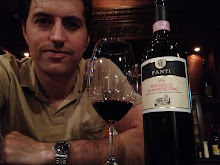Well my blog this week will be focused on your thoughts on wine enclosures. Do you think "cheap, cheap" every time your friend brings out their favorite wine in a screwcap? Or do you let the wine speak for itself? No doubt about it wineries are looking for alternative wine enclosures. I will get to why later in this blog, lets first examine the difference and perception of the two most popular options.
From the Zork, to glass capsules (German), Stelvin (a.k.a. Screwcap), Synthetic Cork, Bag in a Box, to good old fashion cork; do you feel the way it is sealed reflects quality?
Did you know that on average it cost a winery more to bottle wines with Screwcap enclosures than Cork?
Did you know that majority of TCA taint in wines comes from the cork, which is where wine when it is flawed by TCA gets it's corked name?
TCA accounts for the flaw in wine in which the wine losses fruit expression and is replaced by a musky, mildew, wet cardboard aroma that for me finishes with a tongue depressor from the doctor's office aftertaste. It affects up to 1 in 14 bottles bottled in a cork enclosure. Next time you are at a restaurant and something doesn't seem quite right. You may be a victim of TCA. With the cost of shipping and the opportunity cost of having to replace bottles with TCA or wine flaws. Wineries are looking for a way to cut back on returns.
New Zealand has gone 95% Screwcap and it is almost rare now to find wines not in screwcap from these Islands. The thought for them is they predominately produce Sauvignon Blanc which is intended to be consumed in its first year of bottling. So how the wine goes into the bottle will be the exact way it comes out by the end user. There are exceptions to this rule of thumb, but in general it is accurate.
France has really struggled to adopt tolerance for the screwcap enclosure, sighting the wines aren't able to breath properly and it will not be appropriate for the great age worthy wines. Well some evidence shows that wine ages just as well in screwcap versus a high quality cork. As of now, only lower end and bulk negociant producers are using this as an enclosure. Reality check cork comes from cork trees which is becoming harder and harder to find good corks. Some producers higher a cork sampler to smell each cork for any trace of TCA. This is not only expensive but likely a waste of time. Doesn't that seem like the worst job you could have? Its the whole I think this milk is spoiled what do you think.
Italy seems to be in no hurry to adapt this type of enclosures for its wines as well. In fact, really it seems to only be largely used in New World wine growing regions. It seems that Europeans prefer traditions to modern technology. Exceptions are Cell Phones and Stainless Steel Temperature controlled wine-fermenting tanks, but hey those are like the invention of the car.
The most expensive bottle of wine I have found to date in a Screwcap is Plumpjack Reserve Cabernet Sauvignon ($250), which each year releases its wine half in screwcap and the other half in cork. Maybe if they had been the first to use the technology instead of Gallo with jug blush, maybe we would less prejudice to the idea. I think by the end of it all with everyone becoming so environmentally conscience, the winner will be the one that is most green. My vote is to go for the glass enclosure. It is fun and it keeps all material that comes in contact with the wine consistent. What do you think should replace cork?
Subscribe to:
Post Comments (Atom)

No comments:
Post a Comment